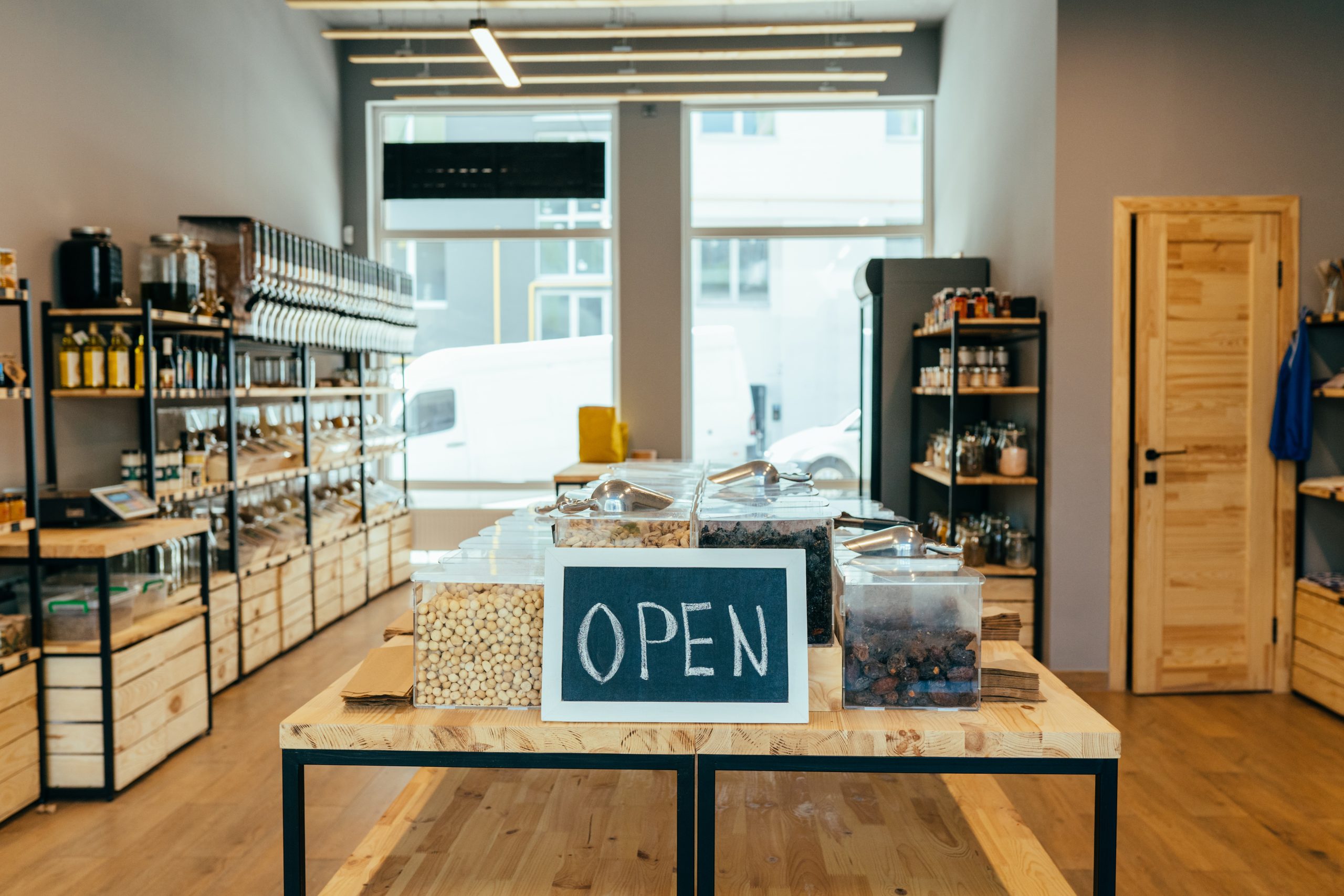Retail Trend #1: Social Commerce
This year’s surge in online shopping is here to stay, especially given the hurdles presented by the COVID-19 pandemic and the closure of brick-and-mortar stores. According to a recent study, in 2020, nearly 41% of customers said they were currently shopping online for things they would normally buy in-store.
Social commerce — native shopping experiences on a social media platform — offers shoppers an even more seamless way to shop online. Instead of clicking through to a third-party website, users can make purchases right from the social media app or site.
And social commerce is on the rise. In 2020 alone, we saw a partnership between TikTok and Shopify, an expansion of Snapchat’s Native Stores for brands, and the introduction of Facebook Shops.
Shops are custom storefronts for businesses on Instagram and Facebook. Sellers can create collections of featured products, as well as modify the look of their Shop with banners, images, colors, and buttons. The same Shop can be accessed from both Facebook and Instagram, so once it’s set up, sellers have the potential to reach a wide global audience on two platforms.
With Shops, Facebook is catering more directly to brands than they have in the past. This is part of Facebook’s effort to create a personalized shopping experience for users in the “Shop” destination of the app, which we expect to become more prominent to users in the near future.
In 2021, we can expect to see social commerce become an even more integral part of the ecommerce experience for brands and shoppers alike.
Retail Trend #2: A New Approach to Influencer Marketing
Influencer marketing used to be all about selfies, carefully-constructed captions, and heavily-edited product shots. But in 2020, we’ve seen a major shift in the way brands and influencers work together. Influencer content has slowly transitioned to a raw, real aesthetic, and this change will continue into 2021.
Audiences put trust in brands that showcase authentic voices, and today’s savvy users can spot an overly-produced ad from a mile away. Brands that don’t prioritize authenticity in their influencer partnerships can wave goodbye to high engagement and ROI next year. It’s time to focus on unique influencer content that prioritizes education, entertainment, and the viewer experience.
From a media mix perspective, video will be 2021’s most important medium for influencer partnerships. With many brick-and-mortar stores closed, shoppers can’t try on apparel or test out gadgets in-store — and a video is the next best thing.
In fact, brands have already started partnering with influencers to create and share content on IGTV, Instagram Live, TikTok, and Instagram Reels to build and foster digital communities. Take fitness authority Bandier, for example. Bandier partners with industry leaders to run workouts on IG Live, then publishes the videos to IGTV for those who miss the livestream. It’s a way to bring the brand’s community together through a shared interest while also demonstrating its gear’s durability.
Overall, brands will need authentic video content to keep their influencer campaigns engaging in 2021.
Retail Trend #3: Online Stores in Offline Spaces
Many digital native, direct-to-consumer brands like Bonobos, Glossier, Casper, and Warby Parker started online, but have since launched and expanded their physical presence over the past few years. Most of the digital brands opening stores sell apparel, which makes sense; it’s a category where shoppers benefit from interacting with the product in person.
Last year, real estate experts predicted that digitally native brands would open 850 brick-and-mortar stores in the next 5 years, with New York being the most popular destination. And while the COVID-19 pandemic has undoubtedly slowed the openings of new brick-and-mortar stores, we’re still seeing offline experiences from previously online-only brands, and will continue to in 2021.
Take the opening of the first brick-and-mortar Amazon Fresh Grocery Store in September, for example. The Amazon Fresh grocery store is a new grocery store designed from the ground up to offer a seamless grocery shopping experience, whether customers are shopping in-store or online.
This new initiative from Amazon brings the ease and accessibility of ecommerce to brick-and-mortar grocery shopping. The Amazon Fresh grocery store offers same-day delivery and pickup, as well as Amazon.com package pickup and returns. Amazon also launched the Amazon Dash Cart to help customers skip the checkout line.
Going into 2021, we can expect to see brands — giant retailers and smaller DTC brands alike — continue to create offline experiences that leverage the technology and convenience of ecommerce.
Retail Trend #4: Even More AR-Powered Shopping Experiences
Augmented reality (AR), machine learning, and artificial intelligence (AI) are here to stay. According to a Nielsen global survey from 2019, consumers listed Augmented and Virtual Reality as the top technologies they’re seeking to assist them in their daily lives, with 51% saying they would be willing to use AR technology to assess products.
And while AR in retail isn’t new (Facebook made some big AR moves in 2018), it’s gone from a nice-to-have to an essential part of retailers’ ecommerce offerings.
As so many shoppers continue to rely on online shopping during the pandemic, retailers leverage AR technology to bridge the gap between the digital and the physical. In fact, IBM’s 2020 U.S. Retail Index reports that COVID-19 has accelerated the shift to digital shopping by roughly five years.
While brands like IKEA, Home Depot, and Target all have proprietary AR shopping experiences, AR-powered commerce isn’t just for mega-brands.
Last year, Shopify introduced Shopify AR, an easy-to-use toolkit for businesses to create their own AR experiences to showcase their products to customers. And it works: Shopify reports that interactions with products having AR content showed a 94% higher conversion rate than products without AR
All in all, look for more brands taking advantage of AR capabilities in 2021 — and more shoppers seeking out those AR experiences to make purchase decisions.
Retail Trend #5: Creative Brand Identities on Amazon
Even as new shopping experiences continue to emerge, Amazon reigns supreme when it comes to online marketplaces. During Q2 2020, Amazon generated its highest net revenue yet — almost 88.91 billion U.S. dollars — even higher than during the holiday shopping quarter (Q4) in 2019.
For brands on Amazon, building brand equity can be a challenge. But a strong brand identity is crucial for connecting with shoppers and establishing trust. The good news? Amazon has introduced more tools than ever for brands to build unique brand identities on Amazon, including:
We expect that Amazon will continue to support brands’ abilities to creatively advertise and differentiate their brand identities going into 2021.
Retail Trend #6: Ethical and Values-Based Brands on the Rise
Transparency, values, and ethics have never been more important to shoppers — which means brands need to prioritize them ASAP.
71% of consumers prefer buying from brands that align with their values. And according to Forrester, shoppers are increasingly evaluating products and brands based on a company’s ethics and values, with 41% of US consumers actively seeking to buy from a company associated with social, environmental, and political ideals.
For brands, this shift to values-based consumers means that brands who are traditionally less forthcoming will no longer be able to get away with hiding any sketchy business practices or environmentally-unfriendly operations.
Offering genuine transparency and taking a stance on ethical issues can be risky for brands, but when done right, it can build lasting customer loyalty and trust.
Retail Trend #7: Same-Day (or Faster) Delivery
It wouldn’t be a retail trend roundup without mentioning fulfillment, especially when sales from same-day shipping pioneer Amazon are higher than ever.
It seems like customer expectations for shipping times are only getting faster. First came 2-day via the rise of Amazon Prime, then next-day, then same-day. And big-box stores are following in Amazon’s footsteps, with Target growing their Shipt service and Walmart expanding their two-hour express delivery options.
But in the age of instant gratification, shoppers want their orders ASAP. And same-day, store-fulfilled orders are seeing more traction from customers and brands alike. PwC reports that 88% of consumers are willing to pay for same-day or faster delivery. From Amazon’s Prime Air — which uses drone technology to deliver shopper’s orders in 30 minutes or less — to the rise of delivery robot startups, delivery is only getting faster.
While same-day shipping is far from a new concept — in 2018, 51% of ecommerce retailers already offered same-day delivery — we’re likely to see it become the norm and beyond as order fulfillment technology and standards evolve in 2021.
Retail Trend #8: Increase in Smart Speaker Shopping
It seems like everyone these days has an Amazon Echo or Google Home.
Smart speaker sales reached a new record in 2019, up 70% from 2018. And it’s still growing: By 2025, projections suggest that the global smart speaker market could grow to over 35.5 billion U.S. dollars.
87.7 million adults in the U.S. own a smart speaker — which equates to an adoption rate of over one-third of consumers.
So, with smart speakers already such a commodity for so many consumers, how will the trend progress next year?
Amazon Echo and Google Home smart speakers have become key tools for many online shoppers, especially as we all spend more time at home during the pandemic. Around 20% of smart speaker owners use them for shopping activities, such as ordering products, conducting product research, or tracking deliveries. This figure is expected to jump to 52% within the next four years.
As we move into 2021, we can expect to see more consumers online shopping without ever having to look at a screen, especially on Amazon. But even brands who aren’t on Amazon can leverage smart speaker and voice search technology. Here’s why: When a voice assistant provides an answer, it also allows users to open the website where the answer was found. For brands that prioritize voice-optimized SEO, this could mean a boost in traffic.
Retail Trend #9: Increased Use of Chatbots
As Covid-19 has limited in-person experiences, retailers have had to severely reduce face-to-face customer support. To meet customers where they are, more and more companies have embraced chatbots and personal assistants. The retail industry was already using this technology prior to the pandemic, along with the banking and healthcare sectors. In fact, chatbots are projected to save these industries over $11 billion by 2023.
Social distancing may be the norm for quite some time, and as a result, we’ll likely see even more players adopt these tools to engage with customers on messaging apps like Kik and Facebook Messenger. Though there are certainly benefits to in-person experiences, chatbots offer companies and users alike some big advantages, like shorter wait times and 24/7 availability. Some brands, like Lego, have even created digital shopping assistants, which give customers personalized gift recommendations based on their answers to a few simple questions. Once a user decides on a product, the chatbot directs them to the website where they can complete the purchase.
It’s also important to note that chatbots can go above and beyond recreating in-person experiences — they can create fun, new experiences unique to the digital space. For instance, in 2016 Sephora used the Kik app to create a personalized prom experience for high schoolers. Partnering with influencer Helen Philips, the brand encouraged subscribers to submit questions for her live tutorial via Kik. They also pushed alerts and prompts on the chatbot prior to the event, which drove engagement on Kik, as well as to the Facebook Live broadcast.
– Prediction courtesy of Movable Ink
Retail Trend #10: Successful retailers become experiential
For companies maintaining physical locations, it’ll be key to distinguish themselves from online retailers by providing unique in-store experiences. Though the reality is that brick-and-mortar stores will sell less, they have the opportunity to provide value by strengthening customers’ relationship to the brand. Immersive, Instagrammable experiences, aka “retailtainment,” can bring the brand alive in a way that digital means can’t.
Take Nike’s Time Square flagship store, for example, which has a basketball court with cameras to record shots and treadmills with screens mimicking famous running routes. Though it’s not a huge sales driver, that’s not its purpose. It’s become a huge tourist attraction that boosts brand engagement and awareness.
Meanwhile, Marvel found a valuable promotional tool in their touring Avengers S.T.A.T.I.O.N., an immersive exhibit that has pulled in huge crowds all around the world. Through interactive displays and real-life movie props, the franchise invites fans to step into the cinematic world that’s delighted them for years.
There’s no mistake that retail will continue to shift to the virtual space, but that doesn’t mean the physical space won’t remain an important one. If used correctly, it can complement its online counterpart to bring a brand to life and give it an edge against competitors.
Retail Trend #11: Ecommerce Grocery Platforms Are the New Norm
Similar to how companies like UberEats and DoorDash changed the delivery landscape, so too is ecommerce reshaping grocery platforms.
Aided by the pandemic, more than 40% of Americans who ordered grocery delivery during the week ending in March 13th also tried it for the very first time in 2020. Even more interesting is that many consumers report they’d like to continue their behavior, post-pandemic.
According to a study by Mercatus/Incisiv, 90% of e-grocery customers are expected to continue shopping online. Once more drastic shelter-in-place orders are lifted, only 7% of online grocery shoppers said they will return to brick-and-mortar stores.
Among all of the burgeoning delivery services, Instacart remains the most popular in North America. Instacart shoppers offer same-day delivery and pickup services to bring fresh groceries and everyday essentials to busy people and families across the U.S. and Canada.
More than half of Americans say that they trust Instacart more than Amazon Fresh and Walmart.
In 2020 alone, Instacart consumed 57% of the grocery ecommerce market and increased their order volume by 500%. Instacart is an undisputed opportunity for brands to acquire and retain online grocery shoppers.
Work-from-home flexibility dramatically increased consumer grocery shopping schedules as well. Instacart reports that the “numbers of orders placed between 9 AM and 5 PM during the workweek rose by 32%.” Instacart also reports that almost a quarter of Americans are doing more shopping during the week, with orders placed on weekdays growing by 8%.
As America’s shopping habits continue to change after COVID-19, an Instacart advertising strategy should be top of mind–if you’re in-store as a participating retailer. Learn more about the top trends dominating Instacart advertising and unpack the latest insights across our digital aisles here.
Retail Trend #12: Increased Focus on Personal Health and Self-Care
In addition to the pandemic changing major consumer businesses, COVID-19 also changed the items that online shoppers prefer to purchase. During the midst of the first wave of the pandemic, consumer attitudes focused heavily on purchasing personal health products. In fact, according to Accenture, 34% of consumers are increasing their purchase of personal hygiene products while cutting back on more discretionary categories.
These changes in spending habits extended well beyond the first wave of the pandemic, as lockdowns increased all over the world. With the rise of these lockdowns, came a rise and a focus on consumer health. Online grocery brands should note these changes, and prioritize the ways they can support healthy lifestyles for consumers, shoppers, and employees.
For instance, consumers are modifying their personal habits such as cleaning more surfaces, increasing their handwashing, and more than 85% of consumers plan to continue these habits following COVID-19. Such changes present opportunities for new personal hygiene offerings within any company’s portfolio. Even virtual tools, such as mediation apps, or anything poised to focus on self-care and mental well-being can be a positive influence not only on consumers but also on overall brand perception in the marketplace.
Article Credit https://tinuiti.com/







